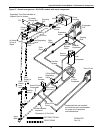
Split System Models
56
7.0 SPLIT SYSTEM MODELS
Three condensing unit styles are available: two air-cooled and one water/glycol-cooled condensing
unit.
7.1 Location Considerations
7.1.1 Air-Cooled Condensing Units
To assure an adequate air supply, it is recommended that all condensing units be located in a clean
air area, away from loose dirt and foreign matter that may clog the coil.
The outdoor condensing unit must not be located in the vicinity of steam, hot air, or fume exhausts or
closer than 18" from a wall, obstruction, or adjacent unit.
The outdoor condensing unit should be located for maximum security and maintenance accessibility.
Avoid ground-level sites with public access or areas that will contribute to heavy snow accumulations.
Do not allow the discharge air to blow into another condensing unit.
The outdoor condensing unit must be located at the same level or above the indoor Liebert Challenger
3000 unit. It must NOT be located below the indoor unit.
A solid base, capable of supporting the weight of the condenser and at least 2" (51 mm) higher than
the surrounding grade and at least 2" (51 mm) larger than the condensing unit base dimensions,
should be installed at the pre-determined location. In snow areas, a base of sufficient height to clear
snow accumulation must be installed.
The centrifugal fan air-cooled condensing unit may be located above the dropped ceiling or any remote
indoor area. If noise is of concern, the condensing unit should be located away from personnel. Normal
operating sound may be objectionable if the condensing unit is placed near quiet work areas.
To mount the unit in the ceiling, refer to 7.5.1 - Installing the Indoor Condensing Unit for hang-
ing guidelines and to Figure 35 - Detail of ceiling hanging bracket for dimensional data.
7.1.2 Water/Glycol-Cooled Condensing Units
The condensing unit may be located above the dropped ceiling or any remote indoor area. If noise is of
concern, the condensing unit should be located away from personnel. Normal operating sound may be
objectionable if the condensing unit is placed near quiet work areas. To mount the unit the in ceiling,
refer to 7.5.1 - Installing the Indoor Condensing Unit.
7.2 Electrical Connections
Refer to equipment nameplate regarding wire size and circuit protection requirements. Refer to elec-
trical schematic when making connections. Make all wiring and electrical connections in accordance
with local and national codes.
7.2.1 Line Voltage
Line voltage electrical service is required for all condensing units at the location of the condensing
unit. This power supply does not have to be the same voltage as the indoor unit. This separate power
source may be 208, 230, 460 or 575V, 60 Hz; or 200, 230, or 380/415V, 50 Hz. A disconnect switch is
required and must be mounted per local and national codes to isolate the unit for maintenance.
!
WARNING
Risk of electric shock. Can cause injury or death.
Potentially lethal voltages exist within this equipment during operation. Observe all
cautions and warnings on unit and in this manual.
The Liebert iCOM microprocessor does not isolate power from the unit, even in the “Unit
Off” mode. The only way to ensure that there is NO voltage inside the unit is to install and
open a remote disconnect switch. Refer to unit electrical schematic.
Use voltmeter to make sure power is turned off before making any electrical connections.


















